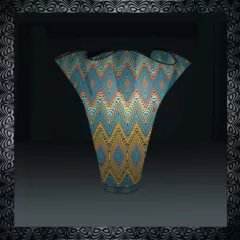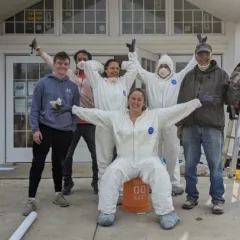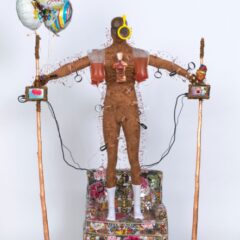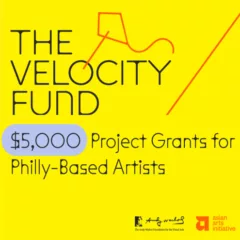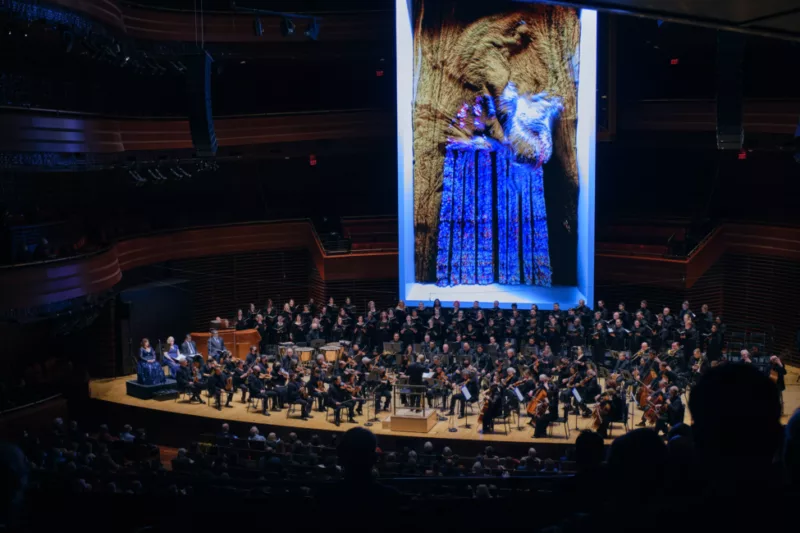
A different kind of art experience occurred in 2022 when the Philadelphia Orchestra and Symphony Choir collaborated with A.I. artist Refik Anadol. Anadol installed a 40’ high screen he called “post digital architecture” behind the orchestra. As the Orchestra performed Beethoven’s Missa Solemnis, the screen came to vivid life with A.I. generated abstract three dimensional forms, “playing” to the music over the next hour. Anadol’s methodology used fluid, dynamic algorithms composed of data derived from 100’s of thousands of images of the world’s cathedrals, sculptures, and paintings. The glowing effects resembled flowing water, wind, and hair recombining into endless shapes synching to the music. Sitting in the audience that night, I found Anadol’s work mesmerizing.
For Anadol, his work is the most ethical application for artificial intelligence. He says, “A.I. is a myth that people think in the most negative way, but actually it can be a tool for humanity, for the next journey. Like any technology, it has a 50% chance of being used for good reasons. I’m not saying that it will never be bad or used for wrong, but the question is: what else can we do with it, such as creating art, beautiful experiences, and positive applications? That’s, I think, very exciting.”
Not everyone agrees A.I. is a good tool for humanity
This past June, Anadol’s huge A.I. installation Glacier Dreams, of melting glaciers, appeared outdoors at Art Basel in the blistering heat. The same day CNN and the New York Times reported that forty-two percent of CEOs surveyed at the Yale CEO Summit say A.I. has the potential to destroy humanity five to ten years from now. Is this hubris or do they know something artists may not?
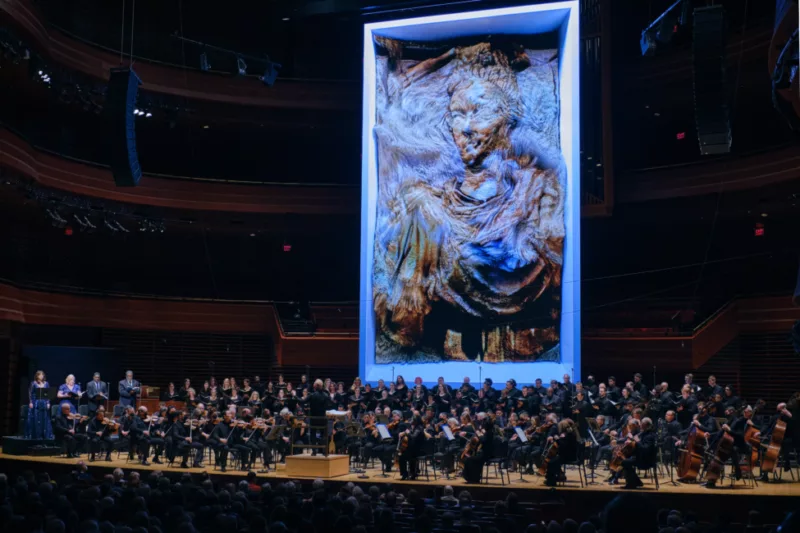
In 1995 when the first digital camera came on the market, film photographers scoffed at digital technology. They couldn’t have imagined the digital universe we live in some 30 years later. Of course now photographers embrace both photographic technologies and understand they are different. Generative A.I.is still in its beginning and promises to become insanely more sophisticated than it is now. And more and more artists are embracing aspects of A.I. technology in their practice as they feel the range of possibilities for self-expression are incredibly seductive. These are the wild west days of A.I. art when anything goes, the gold rush to sell all things A.I., the days before regulation can catch up, if ever. Or, before humanity destroys or transforms itself, depending on whom you listen to.
Excitement and anxiety about how new technology affects the arts
Historically, the integration of new technologies in the arts has consistently upended assumptions and expectation of what art should be. The arts and science are our best bell weather as to how civilization will evolve. As Artificial Intelligence technology radically expands its global presence an equal mix of excitement and anxiety has arisen. An overarching question has been whether A.I. will ultimately replace human creativity, or continue to augment it? In the near term, artists’ concerns center around plagiarism, copyright concerns, lack of lasting content, authenticity or originality, cultural and racial biases systemically embedded in the algorithms, and how to develop legitimate markets for A.I. creatives. These issues and more coming down the pike are in the mix while artists and coders navigate their way through the tsunami of A.I. technology.
A.I. is not new. In 1970, Mashiro Mori, a robotics professor, coined the term “uncanny valley.” It described a phenomenon many have experienced in video games, animated movies, robotics and A.I. art. It is a feeling people receive from an android or avatar that tries to be human but isn’t. Like much of early A.I. art that somehow seems off kilter, it “increasingly resembles a person, its familiarity increases until a point at which it abruptly drops to a negative value and elicits strong repulsion.”** A good example is the 2014 sci fi film Ex Machina that uses the uncanny valley as its theme.
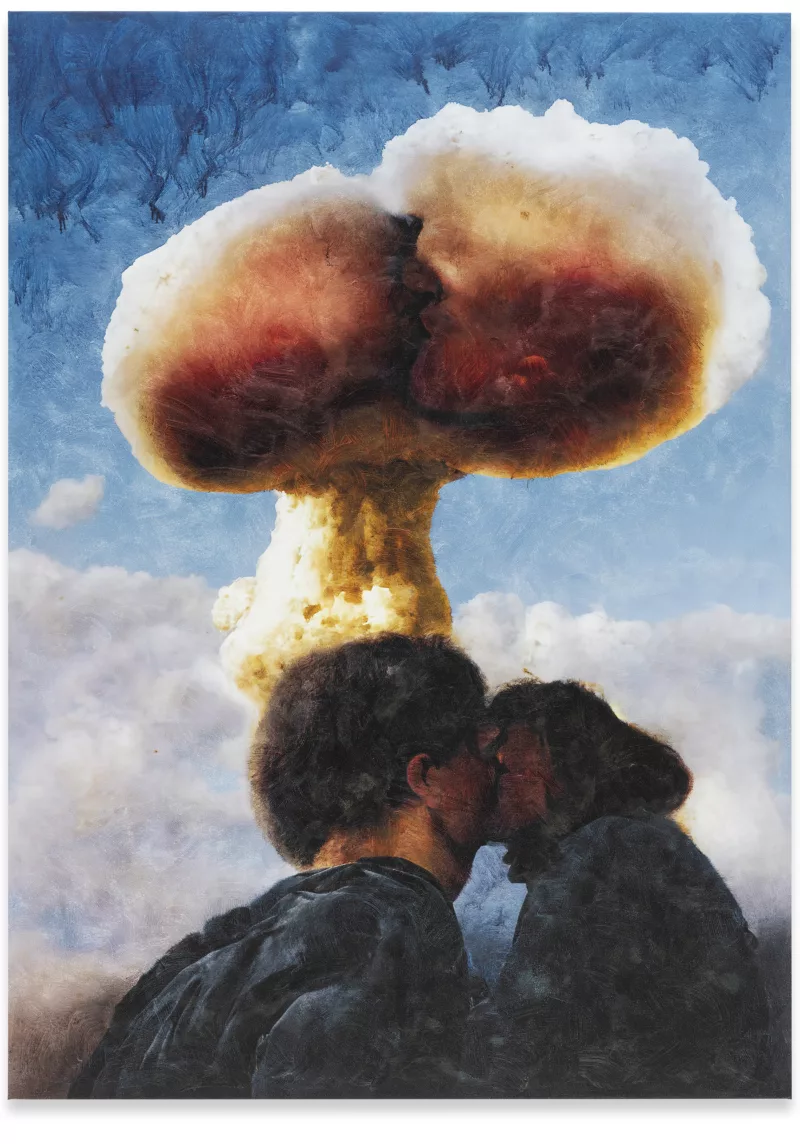
A.I. Distortions, fictions and pranks trigger social media responses and disinformation nightmares
Many A.I. applications seem to produce images that are distortions. Artist Jon Rafman’s 2022 Berlin exhibition at Spruth Magers, Counterfeit Poast, exploits imperfections and biases generated by text to image A.I. algorithms. Matteo Calla in Berlin Artlink aptly described Rathman’s work; “In their content and materiality, these works stage a tension between a pre-modern notion of art as a uniquely human creation, and its existence as the product of an AI algorithm.” This concisely explains the nascent state of A.I. generated art back in 2022.
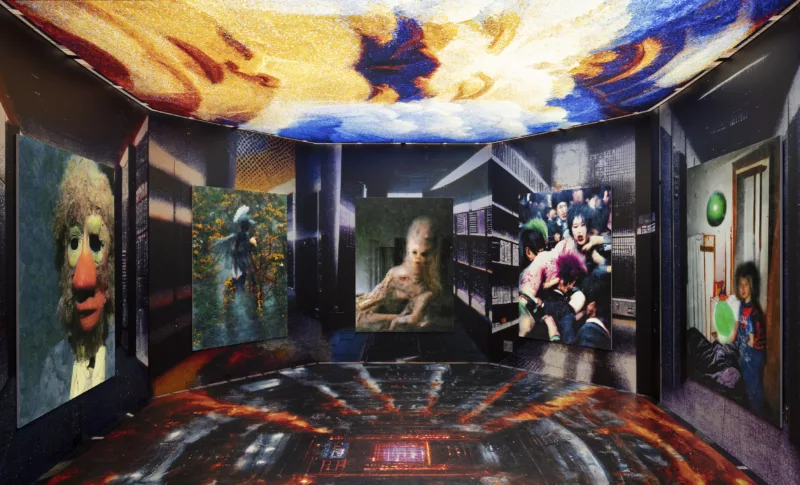
In another arena entirely, recent A.I. virtual artist pranks have gone out of control as social media disinformation. Last April a hilarious series of A.I. generated photos of Donald Trump resisting arrest during his arraignment in New York City appeared online (by Elliot Higgen using Midjourney v5.). While the artist may have been having fun, the images went viral on social media, outraging many MAGA supporters who believed they were real. Twitter lit up with threats of violence.
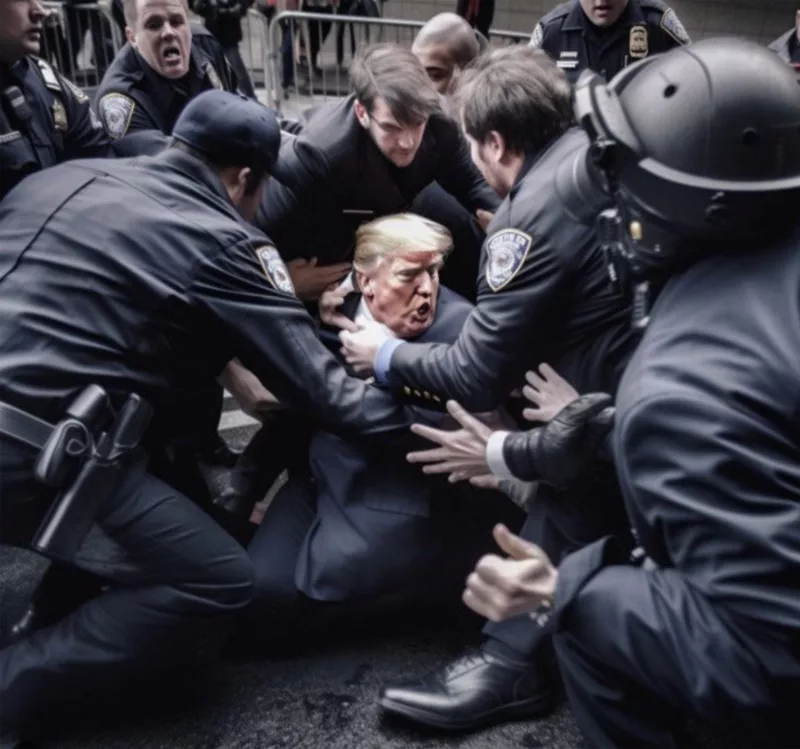
Conversely, equally humorous A.I. generated images of Pope Francis (by Pablo Xavier/Midjourney) wearing a Balenciaga coat caused an internet frenzy among the faithful that so alarmed Elon Musk, a co-founder of OpenAI, he signed a letter along with the co-founders of Apple and Skype saying A.I. posed “profound risks to society and humanity.”
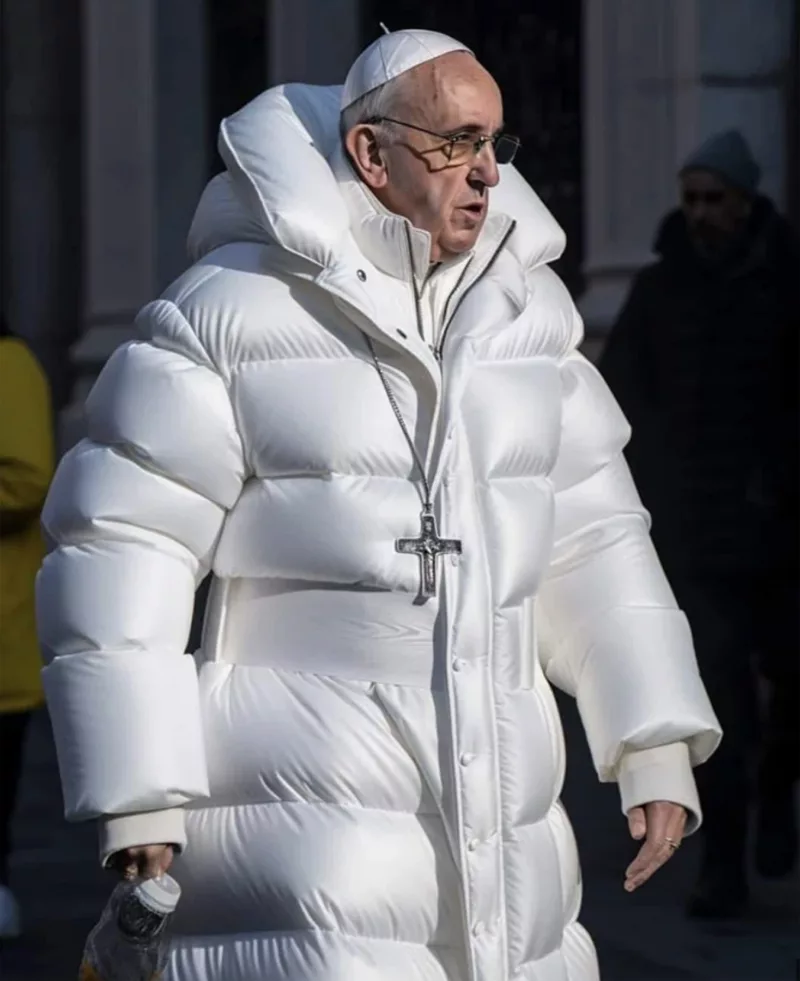
A more far reaching example is the work of Reddit user u/Arctic_Chilean. He can be found on Discord using Midjourney creating convincing fake historical histories employing A.I. generated photos and news stories. His “The 2001 Great Cascadia 9.1 Earthquake & Tsunami” is a fictional documentation about an earthquake that hit the U.S. and Canada in 2001 causing tremendous destruction and death. The fictional history fooled many of the users in his group, who were used to these kinds of projects. With the many conspiracy theories surrounding us (i.e. QAnon, fake elections, holocaust deniers, etc.) it is easy to see how A.I. generated fictional histories could become disinformation nightmares, creating and erasing histories to large segments of gullible populations.
A.I. and artists in a changing field
On the other hand, I wonder if A.I. could be a stimulus to artists who have been wanting to reclaim their power, have agency over their careers and practices? Can A.I. have the promise of positive applications, as Refik Anadol strongly suggests? Or could A.I. be a virtual weapon in the name of transgression in the hands of a few artists who are bad actors? If this seems implausible, so did the digital universe in 1995. There is a lot more to come in the discussion around A.I. and artmaking. The conversation changes weekly, the technology is moving that quickly, and so are the artists invested in it.
Chimaera Gallery’s Philly A.I. exhibit
Currently Philadelphia’s Chimaera Gallery is hosting an online exhibition surveying a range of practitioners using A.I. technology. AI: The Next Evolution manifests the potential, challenges, and aesthetic preferences in this field.
The gallery proposes that “A.I. has given artists new tools to work with and has changed how they think about their work. As AI continues to evolve, its impact on the world will likely only grow.” The artists are an international roster including Alan Lacke, Alfred Stoll, Alex Schecter, Amalia Folka, Amy Karle, Darcel Choy, Diana Sanchez, Edwin Engran, UGLYYKIKI, Lohan Le Galloudec, Maria Bjorkdahl, Miguel Tellez, Mingyong Cheng, Moken Marsai, Suzanne Schneider, Philadelphian Tyler Kline, Vidya Giri, and Yar Kirsanov.
Two artists who represent polar opposites to the many approaches artists take with A.I. are Amy Karle and Maria Bjorkdahl. A.I. has a multiplicity of imbedded presets, styles based on prompts, and packaged applications that create various stylistic outcomes. Amy Karle is a multi-faceted artist whose immersion in infotech and biotech suggests “we are presented with an extraordinary opportunity…to reimagine and reinvent ourselves, our societies, and our future and use our emerging technologies to help us get there. As we meld with our machines, as our biological and artificial realities intertwine, we are not merely creating new technologies; we are creating new versions of ourselves and the world around us.” Her view that technology will transform a post natural world has an undercurrent of sci-fi secular spiritualism reminding me of themes found in novels of Doris Lessing in particular the Canopus in Argos series. Karle’s expression for the desire for total non-binary transformation has a strong resonance.
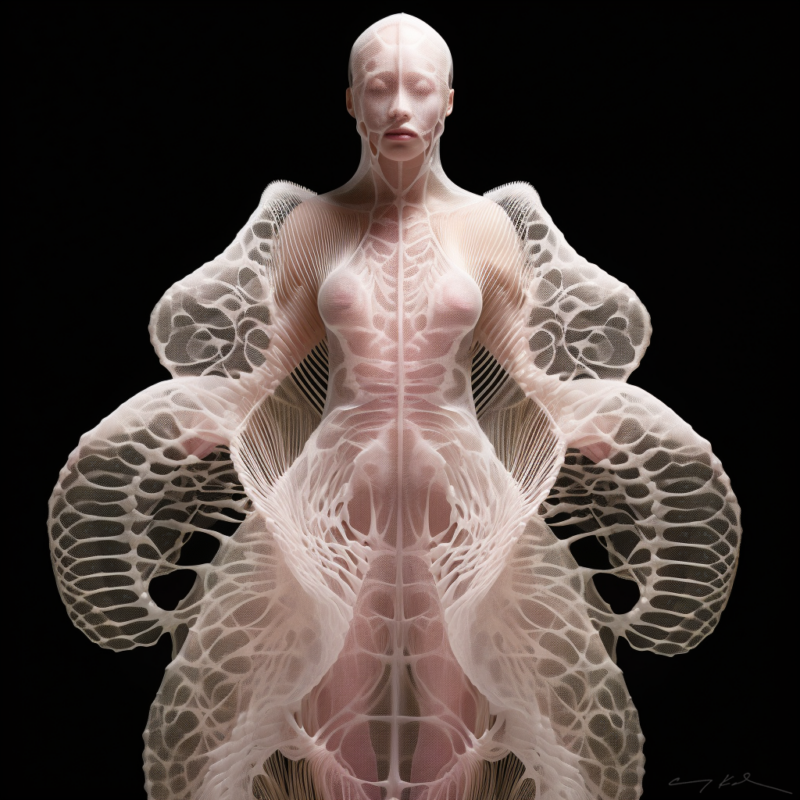
A grounded hybrid approach to the use of A.I is found in the work of Maria Bjorkdahl. She says; “I wanted to contrast the dominant aesthetic of current A.I. art featuring polished figurative/realistic/fantasy imagery, by employing a handmade, imperfect abstract looking aesthetic. I’m interested in blurring the distinction between traditionally viewed authorship of an original piece of art, and A.I. generated, possibly authorless, mass produced image.” Her works are printed in a single edition using archival inks on archival paper, as the artist finds a balance with the handmade and the artificial.
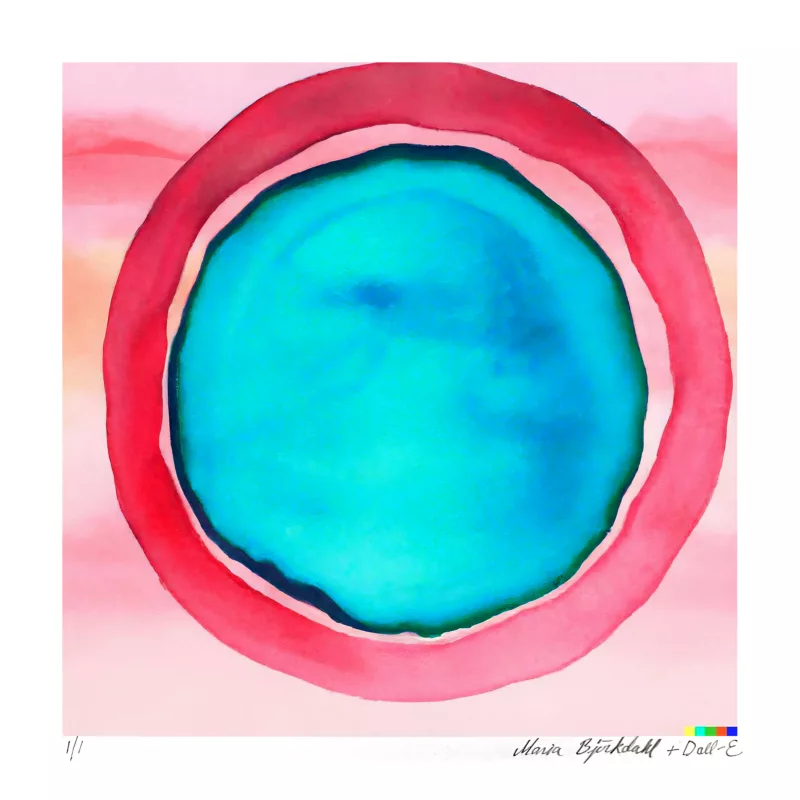
There is a wide scope of work on the Chimaera Gallery platform, all fascinating. Tyler Kline echoes the work of u/Artic_Chilean; Suzanne Schneider falls into the area marked by Refik Anadol; Mingyong Cheng and Diana Sanchez both examine climate change and mass extinction; Darcel Choy and Miguel Tellez envision future worlds of innovative architectural spaces; Lohan Le Galloudec’s vision of devices made living organisms meld with the colors and shapes of art nouveau. It is best to open the site on a desktop and see all of the artists in their fullness. Each one deserves an audience.
Artist Suzanne Schneider’s production relates to the aspirational sentiments Refik Anadol espouses in the beginning of this essay. Schneider says of her work in the Chimaera exhibition: “Smell the Roses” is a meditative video art piece that allows participants take a break from the everyday grind to lay down, meditate, and explore their own personal thoughts and feelings. “Smell the Roses” also takes a look at the current conversations surrounding the ethics of artificial intelligence and explores a unique way to integrate the technology into an art piece.”
‘Is A.I. good or bad for art?’
As a last thought and question, I asked digital artist Christian Knudsen, who has worked extensively with A.I. applications; Is A.I. good or bad for art?
“Sorry for the non-answer but it is neither (or both) in my mind… it is like asking if sampling is good for music, or if collage is good for visual art. A.I. is just another tool or ‘advancement in technology’ that one can use in the creation of art.
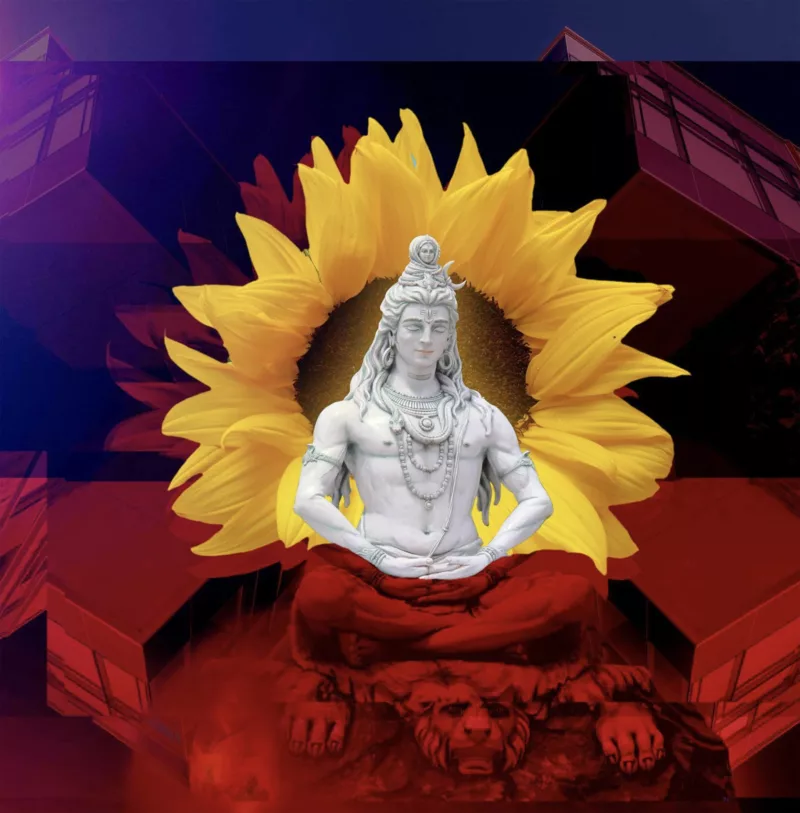
For now, good old fashion words lead the way
That said, I do feel A.I. will fundamentally change the speed at which one can produce certain types of work. You really still need to know your craft if you want to push your A.I. generated artwork in a particular direction, or give it your own artistic flare. I guess what I’m trying to say is that technology is constantly changing the nature of our work, sometimes these changes are small and just seem like part of progress and sometimes they are big enough where they seem like magic (or cheating)….. this is seeming like one of these bigger changes, so it will take some time to adjust our perspectives. It is kind of a ‘black magic box’ right now, even for the coders… but there is an artistry in writing the prompts and to thinking up the ideas to write, and curation in making the variations. As this technology progresses, there will be tools that employ A.I. that give you a more traditional “I’m making art” experience, but right now it is pretty much all about knowing how to communicate what you want to the A.I. with good old fashion words.”
Notes
Wang, S. et al. (2015). The Uncanny Valley: Existence and Explanations. Review of General Psychology, 19(4), 393–407.


